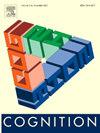What you saw a while ago determines what you see now: Extending awareness priming to implicit behaviors and uncovering its temporal dynamics
IF 2.8
1区 心理学
Q1 PSYCHOLOGY, EXPERIMENTAL
引用次数: 0
Abstract
Past experiences influence how we perceive and respond to the present. A striking example is awareness priming, in which prior conscious perception enhances visibility and discrimination of subsequent stimuli. In this partially pre-registered study, we address a long-standing debate and broaden the scope of awareness priming by demonstrating its effects on implicit motor responses. Using a large sample size (N = 48) and a novel continuous flash suppression (CFS) paradigm, we show that prior conscious perception not only boosts subjective visibility, objective discrimination accuracy, but also enhances implicit motor responses of subsequently encountered threshold-level stimuli. Exploratory temporal dynamics analyses confirm the transient nature of awareness priming: It peaks rapidly and decays gradually, even when high-visibility trials, which could shape subsequent perception, persist. This temporal profile sets awareness priming apart from other influences of prior experience, such as serial dependence or perceptual learning. We also make a novel observation: Recent conscious experience enhances discrimination accuracy, whereas more distant experiences primarily improve subjective visibility. These findings suggest that prior conscious perception shapes conscious awareness and discrimination accuracy through independent mechanisms, likely mediated by brain areas with differing temporal receptive windows across the cortical hierarchy. By shedding new light on the scope and temporal dynamics of awareness priming, this work advances our understanding of how previous conscious perception shapes current perception and behavior.
你之前看到的决定了你现在看到的:将意识启动扩展到内隐行为并揭示其时间动态
过去的经历影响着我们对现在的感知和反应。一个显著的例子是意识启动,其中先前的意识感知增强了对后续刺激的可见性和辨别力。在这个部分预先注册的研究中,我们解决了一个长期存在的争论,并通过展示其对内隐运动反应的影响来扩大意识启动的范围。利用大样本(N = 48)和一种新的连续闪光抑制(CFS)范式,我们发现先验意识知觉不仅提高了主观可见性、客观辨别准确性,而且增强了随后遇到阈值水平刺激的内隐运动反应。探索性时间动力学分析证实了意识启动的短暂性:它会迅速达到峰值,然后逐渐衰减,即使在可能影响后续感知的高可见性试验持续存在时也是如此。这种时间概况将意识启动与先前经验的其他影响(如序列依赖或知觉学习)区分开来。我们还做了一个新的观察:最近的意识经验提高了辨别的准确性,而较远的经验主要提高了主观可见性。这些发现表明,先验意识知觉通过独立的机制塑造意识意识和辨别准确性,可能是由皮层层次上具有不同时间接受窗口的大脑区域介导的。通过揭示意识启动的范围和时间动态,这项工作促进了我们对以前的意识感知如何塑造当前感知和行为的理解。
本文章由计算机程序翻译,如有差异,请以英文原文为准。
求助全文
约1分钟内获得全文
求助全文
来源期刊

Cognition
PSYCHOLOGY, EXPERIMENTAL-
CiteScore
6.40
自引率
5.90%
发文量
283
期刊介绍:
Cognition is an international journal that publishes theoretical and experimental papers on the study of the mind. It covers a wide variety of subjects concerning all the different aspects of cognition, ranging from biological and experimental studies to formal analysis. Contributions from the fields of psychology, neuroscience, linguistics, computer science, mathematics, ethology and philosophy are welcome in this journal provided that they have some bearing on the functioning of the mind. In addition, the journal serves as a forum for discussion of social and political aspects of cognitive science.
 求助内容:
求助内容: 应助结果提醒方式:
应助结果提醒方式:


